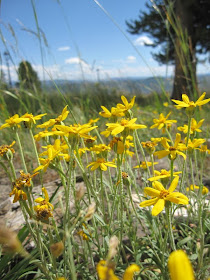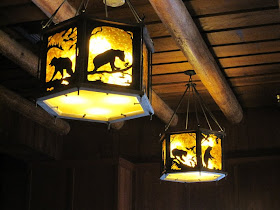 |
| Steamed Milk Mustache at Alterra at the Lake |
 |
| Down the steps to the Art Museum |
 |
| At McKinley Beach |
 |
| Closed for business, open for Leisure |
 |
| Checking out the Barn |
 |
| Can't wait to see what's in the hoophouse |
 |
| Preserving Demo |
 | ||
The Chicken Coop
|
 |
| Keeping a close eye on those hens (she finally fits into this outfit I made her last summer) |
 |
| Cukes for the Compost Pile |
 |
| Staying cool under the solar array |
 |
| Luscious Fresh Apricots! |
 |
| Sauteeing in Butter and Coconut Oil for a Skillet Cobbler |
 |
| Prepped and Ready to Dehydrate |
 |
| Freshly Dried |
 |
| Dried Apricots (a jumbo jar plus a quart) |
Quick Persian Pickles
Yield: 2 quarts
 3 lbs. pickling cucumbers
3 lbs. pickling cucumbers2 1/2 c. distilled white vinegar
1/4 c. granulated sugar (or granulated xylitol)
2 T. pickling or kosher salt
6 whole garlic cloves, peeled
1 T. fennel seed
1 T. cumin seed
1 T. coriander seed
1 T. mustard seed
2 t. whole cloves
1 T. black peppercorns
Thoroughly sterilize jars. For refrigerator pickles you can use any ceramic or glass container with lid. Avoid metal and plastic vessels, as they can impart an off flavor. Wash and gently scrub cukes to remove dirt. Cut about 1/4" from each end. Cut each cuke in half lengthwise and place in large bowl. Combine 2 1/2 c. water with vinegar, sugar, salt, garlic, spices in a medium saucepan over medium-high heat. Bring brine to boil, then reduce heat to low and simmer for 5 min. Remove from heat and cool for 15 min. Pour brine over cukes. Cover the bowl lightly with a cloth, allow to cool for 1 hour. Transfer to refrigerator-bound container, cover with lid, and refrigerate. Pickles will need at least 24 hrs. to absorb flavors of spices. For zestiest, best-tasting results, wait for 1 week before tasting. As refrigerator pickles, they'll keep for about four weeks.
 |
| The lovely spiced brine |
 |
| Sliced and ready for soaking |
 |
| Grape Leaf to maintain crispness |
Sterilize jars and lids according to manufacturer's directions. Wash a place a grape leaf in each quart jar (optional, but will help maintain pickles' crunch.) Keep jars warm as you pack pickles tightly. Added heated brine with spices to the jars allowing 1/2-inch headspace. Remove air bubbles, wipe rims, and place dome lids on jars. Screw on bands until they meet resistance then back just a 1/4-turn. Place in boiling hot water bath and process for 20 minutes. Remove from canner, let cool, label/date, and store in a cool, dark place.
I've also finally processed many of our blackberries. At last I have some homegrown fruit to show for my efforts! The blackberry canes were excellent producers this year despite the fact that I have reason to believe we've been inadvertently feeding a skunk (or family of skunks) with them. We knew these critters were living on our block because of both first- and secondhand accounts. When I'd pick berries, the skunky scent was particularly intense around the bushes. And my sleuthing brought me to a black and white hair pasted to a ripe berry with a slight nibble out of it over the weekend. At least I got most of the harvest before they did.
Blackberry Maple Compote
Makes about 1 1/2 c.
 |
| Freezer Compote |
2 c. blackberries, coarsely chopped
2 T. maple syrup
2 T. maple sugar or sucanat
1 t. fresh ginger juice
1 1/2 t. lemon juice
Tiny pinch of fine-grain sea salt (for balance)
 Combine one-third of the berries along with the maple syrup and sugar in a small saucepan over medium heat. Gently simmer for 3 min. Drain the syrup through a strainer into a bowl, pressing on the berry solids to extract as much juice as possible. Discard solids and combine with syrup with remaining uncooked berries. Stir in the ginger juice, lemon juice, and salt. Taste and adjust with more lemon juice or ginger juice, if needed. The compote will keep for up to 1 week in the refrigerator. Note: I went ahead and froze it in a freezer-quality Mason jar allowing enough headspace for expansion during freezing.)
Combine one-third of the berries along with the maple syrup and sugar in a small saucepan over medium heat. Gently simmer for 3 min. Drain the syrup through a strainer into a bowl, pressing on the berry solids to extract as much juice as possible. Discard solids and combine with syrup with remaining uncooked berries. Stir in the ginger juice, lemon juice, and salt. Taste and adjust with more lemon juice or ginger juice, if needed. The compote will keep for up to 1 week in the refrigerator. Note: I went ahead and froze it in a freezer-quality Mason jar allowing enough headspace for expansion during freezing.) Also trying to use more of the edible flowers I've grown. Already posted about the nasturtiums I recently preserved. This time I was trying to get creative with borage, a cucumber-flavored purple flower. I may be stretching the definition of "pesto," but came up with what I thought would work as a lovely addition to baked or grilled fish--at least that was my initial taste instinct as I sampled the final product.
 |
| Borage flowers |
Makes about 8-1/4 oz. servings
Freeze this pesto in small portions if you wish.
2 cucumbers, peeled and seeded
 about 1/4 c. salt
about 1/4 c. salt1 clove garlic, chopped
Couple handfuls of borage leaves and flowers
2 T. pine nuts
1 T. nutritional yeast
1 T. sesame seeds
Slice cucumbers about 1/4-inch or thinner and place them in a strainer. Sprinkle with salt and toss. Let strainer sit over a bowl for 2-3 hours so that liquid will drain from the cukes. Discard liquid (or save for another use...though keep in mind it's very salty!), squeeze cukes to remove additional liquid. Put all ingredients in a food processor and pulse until combined, but still slightly coarse. Portion and freeze or use immediately.
 |
| "Pesto" ready to freeze |
 |
| Cooked Quinoa (L), Millet (R) |
Serves 6-8
2 c. water
1 c. quinoa, rinsed
1 c. millet
1 1/2 c. chopped tomatoes
1 1/2 c. chopped cucumber
1/3 c. chopped fresh parsley
1/4 c. chopped fresh mint
1/4 c. chopped scallions (green and white parts) or chopped chives
3 T. flaxseed oil (or olive oil)
2 T. fresh lemon juice
 |
| Multi-Grain Tabouli |
1/2 t. salt, or to taste
1/4 t. pepper, or to taste
In a saucepan, bring the water to boil. Add quinoa and millet and return to a boil. Reduce heat and simmer, covered, 20 min., or until liquid is absorbed. Let cool on a shallow sheet tray. In a large bowl, toss grains, tomatoes, cucumbers, herbs, scallions until combined. In a small bowl, stir together oil, lemon juice, vinegar, salt, pepper. Pour over salad, toss to combine.
What else is coming down the pipe? Just harvested my carrots the other night and am preparing to make pickled carrot spears. Stay tuned.
 |




































































